- Home
- Bobby Akart
Pandemic: Quietus: A Post-Apocalyptic Dystopian Fiction Series (The Pandemic Series Book 4) Page 2
Pandemic: Quietus: A Post-Apocalyptic Dystopian Fiction Series (The Pandemic Series Book 4) Read online
Page 2
Quandary Peak – A 14er, terminology for a Rocky Mountain peak in excess of fourteen thousand feet. The Hagans have a second home just below the treeline near Blue Lakes at the base of Quandary Peak.
Cheyenne Mountain – location of NORAD and the hideaway for the President as part of Continuity of Government.
Star Ranch – The first of many safe zones around the country. A gated community, Star Ranch was used to house a select number of local citizens who would participate in the rebuilding effort.
Secondary Scene Locations
Guatemala – Location of the initial outbreak was in the jungle near the small town of El Naranjo. Mac and Janie begin their investigation when they meet the mysterious operative with the DTRA—Hunter. The CDC has a regional office in Guatemala City, about a mile from the United States Embassy.
Turkey – Several temporary camps for Syrian and Iraqi refugees were created in the western part of the country near Izmir, Turkey. In the surrounding countryside, migrant farms were established to pay the refugees and keep them busy during the day until they could emigrate to Europe.
Greece – In Athens, Hunter visits with his contemporaries at the Greek National Intelligence Service. By coincidence, Mac is investigating a case at the Hellenic Centre for Disease Control and Prevention. The two cross paths at a hotel and have dinner together. A spark of interest takes place after they overcome their first chance meeting in the jungles of Guatemala.
CDC – Atlanta – located near Emory University in Atlanta, Georgia.
White House – Washington, DC. Politics plays a pivotal role in all aspects of our lives and the center of the political universe is the White House.
Park Place on Peachtree – Mac’s condominium in Buckhead.
Previously in The Pandemic Series
Book One: BEGINNINGS
The Pandemic Series begins with the kidnapping and interrogation of a young French research scientist in a remote biosafety laboratory in Franceville, Gabon. The terrorist cell run by Ali Hassan, the son of a top-level ISIS leader, also established a complex surveillance apparatus of the young scientist’s family.
Forced to do their bidding in order to save the lives of his family, the French scientist modified the Madagascar strain of the pneumonic plague. His work was groundbreaking, although it was clearly a crime against humanity. In the end, he didn’t save himself, or his family.
Initially, Hassan used the remote jungles of Guatemala as his testing ground. However, a series of events accelerated his plans as outbreaks of the disease occur in Trinidad and Greece.
Hassan, his trusted his allies, and thousands of sleeper cells around the world sprang into action. First, they secured their loved ones away from the harmful potential of the disease. Second, they issued a call to action—the flag of Allah and jihad has been raised.
Hunter and his comrades at the DTRA comprising Project Artemis began to chase leads and search for the bioterrorists. Mac and her fellow disease detectives at the CDC raced to identify the disease, and determine if a vaccine or cure was available.
As the disease spread and the death toll rose, Mac became increasingly frustrated with the President and his administration for not warning the public. She was admonished to do her job and not approach the media with alarmist statements. However, like her mother, Mac believed in transparency and the ability of the public to make decisions for themselves.
When the Congress set up special hearings on the Guatemala breakout and its potential impact on the United States, Mac made a decision. Wearing her dress white uniform indicating her status as a Lieutenant Commander in the U.S. Public Health Service, she decided to add to her attire. She added white gloves, an N95 particulate mask, and protective eyewear.
Her appearance immediately created a ruckus within the large gathering of media covering the hearings. It also raised the ire of the partisan congressman who support the President in his re-election efforts.
Perhaps it was Mac’s attire, or maybe it was the typical partisan bickering which had consumed Washington, but the hearings immediately turned contentious. With the CSPAN cameras rolling, Mac was grilled with questions and placed under considerable pressure. She was asked to describe how the disease affects the human body and she gladly answered in excruciating detail.
Unscripted, but as if on cue, a man in the gallery began to cough up blood, causing a panic by all the attendees. During the stampede for the exits, the man vomited up blood, which immediately drew comparisons to plague-like symptoms. Throughout the ordeal, Mac sat silently, alone, staring at the CSPAN cameras which never turned off.
Meanwhile, in a thousand cities around the world, ISIS operatives continued to relentlessly pursue their Caliphate. As the mayhem took place in Room 2123 of the Rayburn House Office Building, Hassan and his trusted Islamic brothers approached the outskirts of Los Angeles.
From the final chapter of BEGINNINGS …
The rental car sped past the sign that read Welcome to Los Angeles, population 3,957,875.
“We are here, Hassan.”
Hassan nodded. “We are everywhere, my brothers.”
Book Two: THE INNOCENTS
The Pandemic Series continues with the world’s population dwindling. After crisscrossing the planet in search of clues, Mac and Hunter realize this infectious disease is like no other, and with the jihadists implementing the plague as a tool of bioterror, there is not just one Patient Zero, but thousands.
Mac willingly followed in her mother's footsteps, electing to disregard her orders which came straight from the President of the United States. She rang the clarion bell, a warning to the world, that no one is immune or safe from the perfect killer.
Her heroic act got her fired but Hunter quickly came up with a viable alternative. Mac came on board with the DTRA and CIA at a covert laboratory located at a former CDC BSL-4 in Fort Collins, Colorado.
Mac and her family had significant roots there. Her Mom was a resident at Denver Health where Mac was born. The Hagan’s owned a second home at Quandary Peak just south of Breckenridge in the Rocky Mountains.
While Mac worked on a vaccine and cure, Hunter was reassigned to the Denver field office of the FBI. He spent his working hours tracking the jihadists as they entered America, hoping to find the mastermind of the bioterrorist plot. During his off hours, Hunter was getting prepared for the inevitable — societal and economic collapse.
Darting around town from Costco to Walmart to REI Sporting Goods, Hunter systematically equipped the Hagan home at Quandary Peak for the impending apocalypse.
The day came when Hunter was face-to-face with his nemesis, Ali Hassan, the mastermind behind weaponizing the plague and advancing the final jihad. The two men locked eyes and Hunter took care of business. One dead terrorist, but one massive plague was waging the war.
Across the country, terrorist cells infiltrated airports, sporting events, and shopping malls, spreading the disease and infecting thousands, who in turn infected thousands more. They were winning and our governmental response was weak.
President Garcia slowly retreated into a bottle of brandy. His cabinet began to lose confidence in his leadership. The nation was a ship without a rudder, helpless to combat the most dangerous disease known to man.
Mac reached back to her days in college for solutions. She proposed an unproven remedy based upon her college thesis to Janie, who then provided it to her associates at the CDC. Despite Mac’s warnings that the proposed solution was untested, out of desperation, the President and the CDC declared it to be a viable cure and began to inoculate American citizens.
The BALO vaccine was a bust and mac went back to the drawing board. In the meantime, the United Nations and the World Health Organization threw in the towel. A secretive Security Council meeting directive adopted during the Ebola crisis, and incorporated into law by the President, provided a drastic measure to save humanity.
From the final chapter of THE INNOCENTS …
“It’s from Homeland Secur
ity. Hunter, my God. They’ve declared a Level 6 Emergency.”
“Don’t you mean a phase six, based upon the WHO’s pandemic alert system?” asked Hunter.
“No, read it.” Mac spun the monitor around for Hunter to read the short, two-sentence email. “Phase six is where the WHO considers the overall severity of a pandemic to be moderate to extreme. It’s rarely used, but appropriate now.”
Mac began to pace and then she got angry. She swept all the stacks of files off her desk and pounded the corner with her fist.
Hunter tried to console her, but she pulled away. “Mac, we know it’s bad. I don’t under—”
She threw her arms up and looked toward the ceiling. Then she turned to Hunter, arms crossed. “I thought this was the stuff of urban legend. You know a myth only made up on television.”
“The situation is grave,” interrupted Hunter. “Why are you so angry at them declaring a phase six pandemic?”
“No, Hunter. Don’t you see? It didn’t say phase six. They wrote level 6 in the email.”
“They?”
“Yes, see the bottom?” asked Mac as she spun the monitor on her desk for them both to see. She angrily tapped the part of the email indicating the signature field. “It’s signed by the DHS and the UN. They’ve given up, Hunter. They know they can’t contain it or stop it. The United Nations and our own government think this is an extinction-level event. It’s over. My God!”
Mac walked back and forth through the room, hands firmly planted on her hips.
“Mac, what does level 6 mean?”
“Eradication, Hunter. Level 6 is their code word for eradication of the diseased members of the species.”
Book Three: LEVEL 6
In Level 6, book three of The Pandemic Series, the spread of the deadly strain of the plague has hit a brick wall, but not because it’s burned itself out. Rather, the plague bacterium was running out of victims.
While the Hagans, Hunter and Janie attempt to get settled into a routine at their secluded mountain home at Quandary Peak, the government began to carry out the dictates of the Level 6 protocol. Their goal: Stop the spread of the plague. Their method: Eradicate those who are infected, or exposed to the disease.
Life for those lucky enough to survive became more difficult. The power grid went down, law enforcement was non-existent, and survival of the fittest became the norm. The death toll had risen to the point where less than ten percent of the world’s population remained alive.
The government continued to operate from within the safe confines of Cheyenne Mountain and President Garcia makes a bold move to punish those responsible for the pandemic by ordering a nuclear strike against ISIS. While it obliterated the command-and-control structure of the terrorist organization, it would not necessarily stop the final jihad.
Meanwhile, Mac continued her work inside the laboratory built in the basement of their Quandary Peak home. As she focused on her testing, Hunter began to establish security for their home. Dead bodies and missing persons were brought to his attention. He got the sense there was evil lurking in the mountains and valleys surrounding Breckenridge.
His concerns came to the forefront when three major fires broke out on the ridges surrounding the town, one of which threatened Doc Cooley’s ranch. Hunter and Tommy rushed to help their friends. Hunter became disoriented while fighting the fire and almost died. Tommy saved the life of a little boy but became infected with the plague in the process.
Despite all of their precautions, in a moment of compassion, Mac’s father was now on the path of becoming a victim. Lying in the bed of what had become known as the Quarantine House, Tommy and his new friend, Flatus, fought the disease on their own. But gradually, the symptoms became worse.
From the final chapter of LEVEL 6 …
“Second day in a row, after I wake up,” he said. “It’s moving into my chest. I feel like I can’t breathe. The chest pains have increased and I can’t seem to shake the chills.”
“I know, Daddy,” said Mac as she fought back tears. Her father had lost several pounds in the last week and looked completely drained of energy. It hurt her to the core. “I’ve been working on this daily. It’s the best I’ve got so far.”
Mac displayed the six vials and picked up a syringe off the nightstand. She drew the vancomycin out of the first vial and was about to inject her father when he raised his arm.
“No, Flatus first,” he said.
“What? Daddy, this is for you. I only have—” Mac protested.
“Honey, can you make more?” he asked as another coughing fit overcame him.
“Sure, of course.”
Tommy waved his arm toward Janie. “Janie, you’re the vet. Flatus first. He and I are a package deal.”
Mac looked down at her father and she began crying out of pride. This man, who had raised her unselfishly throughout her life, was still thinking of others as he lay on his deathbed. The tears streamed into her goggles and mask. She was shaking from emotions as she turned and handed the needle to Janie, with a nod of approval.
Janie kneeled on one knee and injected Flatus in the shoulder. He panted, but never moved. He was feeling the effects of the disease now as well.
Mac regained her composure and calmed her nerves. She emptied another vial into a fresh syringe. She lifted her father’s arm and wiped the sweat off with a cotton ball. Mac slowly inserted the needle into his vein and depressed the plunger.
Vancomycin-d-ala-d-lac entered his bloodstream and immediately, with every beat of her father’s heart, moved throughout his body to fight the most vicious killer known to man.
The saga concludes in — Quietus
Enjoy!
Epigraph
Throughout the millennia, extinction has been the norm and survival, the exception.
*****
Humanity, if it remains confined to this planet, will eventually succumb to an extinction event.
~ Elon Musk
*****
Death is the wish of some, the relief of many, and the end of all.
~ Lucius Annaeus Seneca
*****
Survival can be summed up in three words — never give up.
~ Bear Grylls
*****
God gives every bird its food, but He does not throw it into its nest.
~ J. G. Holland
*****
Here is the world. Beautiful and terrible things will happen. Do not be afraid.
~ Frederick Buechner
Prologue
Quietus est … he is quit.
Quandary Peak
Nothing was more emotional than preparing for the impending death of a loved one. Most were unprepared to understand the end-of-life process. Some remained in denial, refusing to express their loss openly. Others handled the pain by putting on a false front, by dealing with the business and legal aspects of a loved one’s passing.
In a post-apocalyptic world, there were no distractions. No wills to write. No safe deposits and bank accounts to close. No friends and family to notify on Facebook. Sitting vigil at the bed of the one you love was very personal, intense, and spiritual. With the rate of death, it had also become a common, everyday experience for most.
Grieving a violent death was different from normal mourning behavior. Death caused by human intent left the bereaved loved ones with an obsessive need to assign blame, search for reasons, or dwell on the missing details of what happened and why.
Violence with your fellow man during the apocalypse will be a given. Humans were six times more likely to kill each other than the average mammal. Most animals used aggressive displays to ward off competitors for food or their mates without the intention of causing death. Predators kill for sustenance by preying upon species other than their own.
Man is different. Violence was part of our evolutionary process. Over time, however, humans became less prone to natural or even chaotic violence. Otherwise, we wouldn’t have survived throughout the millennia.
But t
he ability to commit violent death, to take another human’s life, was buried deep within us, waiting for the right set of circumstances to come to the surface. What triggered our ability to kill our fellow man was in part biological, dating back to before humans existed as a species. Other triggers were ingrained from our social and cultural practices. After society collapsed, the ability to kill with little remorse most likely came out of our innate desire to survive.
Once infected by the plague, death was expected as part of the natural processes dictated by the disease. It wasn’t death at the hands of violence per se. It was, however, a violent way to die.
Death was never easy to accept, and the torturous time associated with the dying process was unnerving. Around the world, humanity was experiencing death. Violent deaths occurred, to be sure. But the vast majority of the approximately seven billion people who died during the pandemic did so based upon the plague’s timeline—in days nine through twelve after contracting the disease.
For the disease stricken, death came slow and it was agonizing. Some of the victims suffered alone, and others with available friends and families. There were no grief counselors. No toll-free hotlines to seek advice. Spiritual support from clergy was unavailable. Death was lonely and it hurt more with each passing day.
In some cases, their loved ones provided comfort. They sat watch at the deathbed, completely unprepared for what they were facing. Some found the experience of death firsthand to be, in many ways, similar to birth. It was the essence of life. For others, their unimaginable sorrow placed a sense of guilt upon the dying.
More than one dying soul wondered—would I be better off dying a violent death at the hands of my fellow man—quick and easy? Or perhaps I should die at my own hands to relieve the sorrow of my loved ones and unburden those who grieve for me?

 Geostorm The Collapse: A Post Apocalyptic EMP Survival Thriller (The Geostorm Series Book 3)
Geostorm The Collapse: A Post Apocalyptic EMP Survival Thriller (The Geostorm Series Book 3)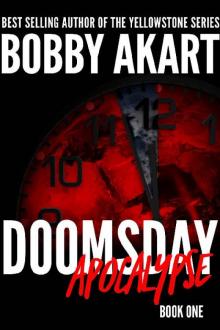 Doomsday Apocalypse
Doomsday Apocalypse Nuclear Winter Desolation: Post Apocalyptic Survival Thriller (Nuclear Winter Series Book 5)
Nuclear Winter Desolation: Post Apocalyptic Survival Thriller (Nuclear Winter Series Book 5) Economic Collapse (Prepping for Tomorrow Book 2)
Economic Collapse (Prepping for Tomorrow Book 2)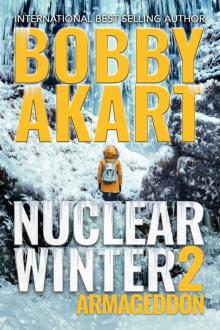 Nuclear Winter Armageddon
Nuclear Winter Armageddon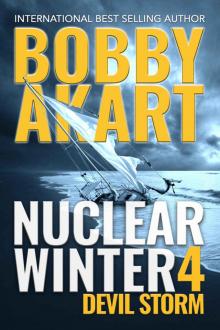 Nuclear Winter Devil Storm
Nuclear Winter Devil Storm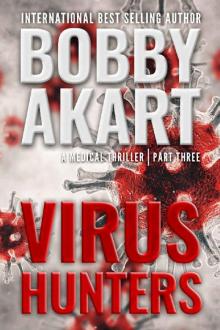 Virus Hunters 3: A Medical Thriller
Virus Hunters 3: A Medical Thriller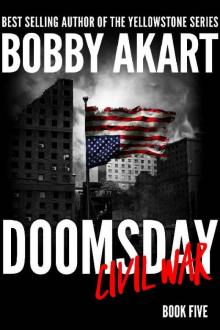 Doomsday Civil War: A Post-Apocalyptic Survival Thriller (The Doomsday Series Book 5)
Doomsday Civil War: A Post-Apocalyptic Survival Thriller (The Doomsday Series Book 5) Asteroid Destruction
Asteroid Destruction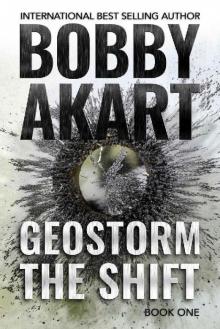 Geostorm the Shift
Geostorm the Shift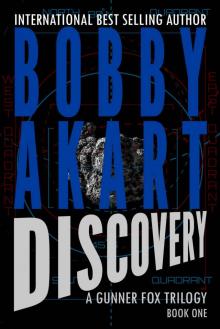 Asteroid Discovery
Asteroid Discovery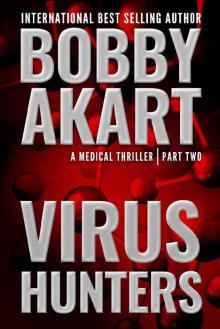 Virus Hunters 2: A Medical Thriller
Virus Hunters 2: A Medical Thriller Geostorm The Shift: A Post-Apocalyptic EMP Survival Thriller (The Geostorm Series Book 1)
Geostorm The Shift: A Post-Apocalyptic EMP Survival Thriller (The Geostorm Series Book 1) Asteroid Diversion
Asteroid Diversion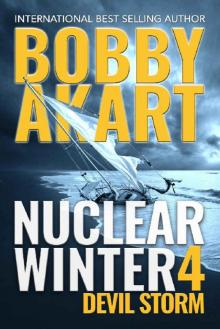 Nuclear Winter Devil Storm: Post Apocalyptic Survival Thriller (Nuclear Winter Series Book 4)
Nuclear Winter Devil Storm: Post Apocalyptic Survival Thriller (Nuclear Winter Series Book 4) Geostorm The Pulse: A Post Apocalyptic EMP Survival Thriller (The Geostorm Series Book 2)
Geostorm The Pulse: A Post Apocalyptic EMP Survival Thriller (The Geostorm Series Book 2) Yellowstone: Survival: A Post-Apocalyptic Survival Thriller (The Yellowstone Series Book 4)
Yellowstone: Survival: A Post-Apocalyptic Survival Thriller (The Yellowstone Series Book 4) Nuclear Winter First Strike: Post-Apocalyptic Survival Thriller
Nuclear Winter First Strike: Post-Apocalyptic Survival Thriller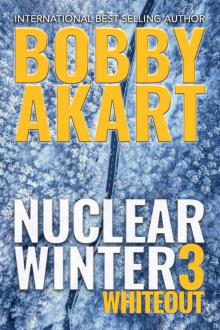 Nuclear Winter Whiteout
Nuclear Winter Whiteout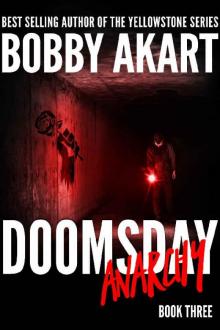 Doomsday Anarchy
Doomsday Anarchy Pandemic: Level 6: A Post Apocalyptic Medical Thriller Fiction Series (The Pandemic Series Book 3)
Pandemic: Level 6: A Post Apocalyptic Medical Thriller Fiction Series (The Pandemic Series Book 3) Martial Law
Martial Law Odessa Reborn: A Terrorism Thriller (Gunner Fox Book 4)
Odessa Reborn: A Terrorism Thriller (Gunner Fox Book 4)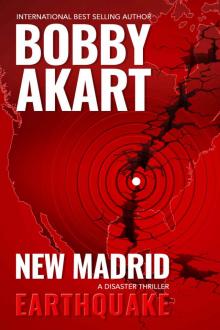 New Madrid Earthquake
New Madrid Earthquake Beyond Borders: Post Apocalyptic EMP Survival Fiction (The Lone Star Series Book 2)
Beyond Borders: Post Apocalyptic EMP Survival Fiction (The Lone Star Series Book 2) The Blackout Series (Book 3): Turning Point
The Blackout Series (Book 3): Turning Point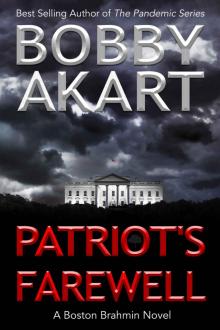 Patriot's Farewell: A Political Thriller Fiction Series (Boston Brahmin Political Thrillers Book 7)
Patriot's Farewell: A Political Thriller Fiction Series (Boston Brahmin Political Thrillers Book 7) Lines in the Sand_Post Apocalyptic EMP Survival Fiction
Lines in the Sand_Post Apocalyptic EMP Survival Fiction The Mechanics: A Post-Apocalyptic Fiction Series
The Mechanics: A Post-Apocalyptic Fiction Series The Loyal Nine
The Loyal Nine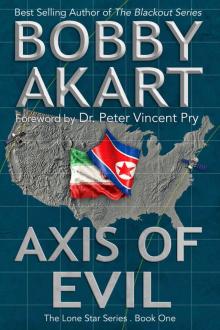 Axis of Evil
Axis of Evil Axis of Evil: Post Apocalyptic EMP Survival Fiction (The Lone Star Series Book 1)
Axis of Evil: Post Apocalyptic EMP Survival Fiction (The Lone Star Series Book 1) Lines in the Sand: Post Apocalyptic EMP Survival Fiction (The Lone Star Series Book 3)
Lines in the Sand: Post Apocalyptic EMP Survival Fiction (The Lone Star Series Book 3) Odessa Strikes
Odessa Strikes The Blackout Series (Book 4): Shiloh Ranch
The Blackout Series (Book 4): Shiloh Ranch Hornet's Nest: A Post Apocalyptic EMP Survival Fiction Series (The Blackout Series Book 5)
Hornet's Nest: A Post Apocalyptic EMP Survival Fiction Series (The Blackout Series Book 5)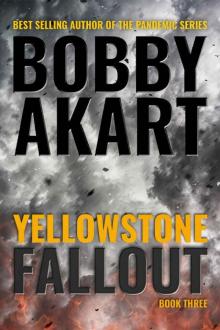 Yellowstone: Fallout: A Post-Apocalyptic Survival Thriller (The Yellowstone Series Book 3)
Yellowstone: Fallout: A Post-Apocalyptic Survival Thriller (The Yellowstone Series Book 3)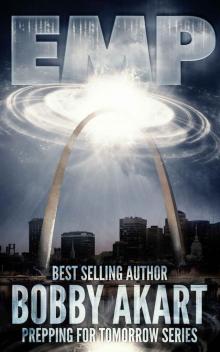 Electromagnetic Pulse
Electromagnetic Pulse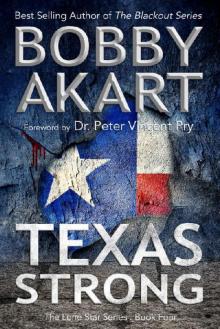 Texas Strong: Post Apocalyptic EMP Survival Fiction (The Lone Star Series Book 4)
Texas Strong: Post Apocalyptic EMP Survival Fiction (The Lone Star Series Book 4)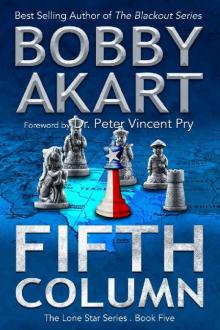 Fifth Column_Post Apocalyptic EMP Survival Fiction
Fifth Column_Post Apocalyptic EMP Survival Fiction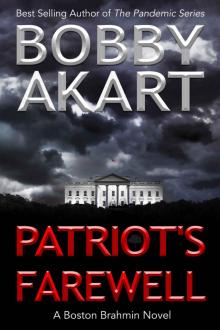 Patriot's Farewell
Patriot's Farewell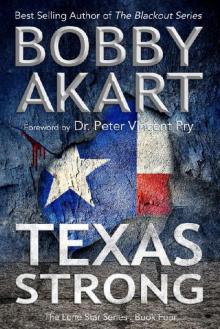 Texas Strong_Post Apocalyptic EMP Survival Fiction
Texas Strong_Post Apocalyptic EMP Survival Fiction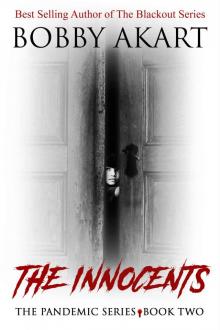 Pandemic: The Innocents: A Post-Apocalyptic Medical Thriller Fiction Series (The Pandemic Series Book 2)
Pandemic: The Innocents: A Post-Apocalyptic Medical Thriller Fiction Series (The Pandemic Series Book 2) Shiloh Ranch: A Post Apocalyptic EMP Survival Fiction Series (The Blackout Series Book 4)
Shiloh Ranch: A Post Apocalyptic EMP Survival Fiction Series (The Blackout Series Book 4)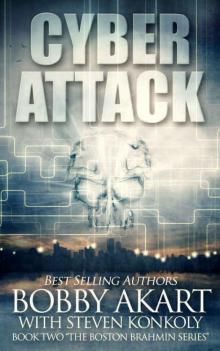 Cyber Attack
Cyber Attack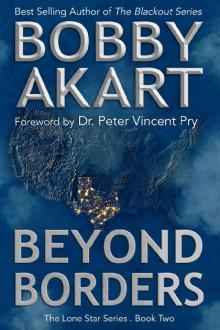 Beyond Borders
Beyond Borders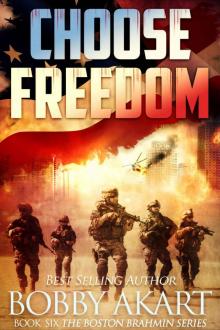 Choose Freedom: A Post-Apocalyptic Fiction Series (The Boston Brahmin Book 6)
Choose Freedom: A Post-Apocalyptic Fiction Series (The Boston Brahmin Book 6)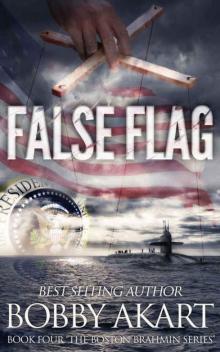 False Flag
False Flag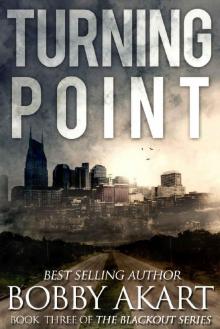 Turning Point: A Post Apocalyptic EMP Survival Fiction Series (The Blackout Series Book 3)
Turning Point: A Post Apocalyptic EMP Survival Fiction Series (The Blackout Series Book 3)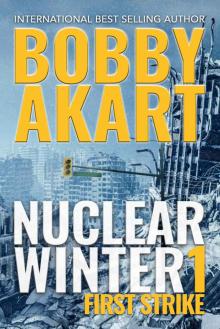 Nuclear Winter First Strike
Nuclear Winter First Strike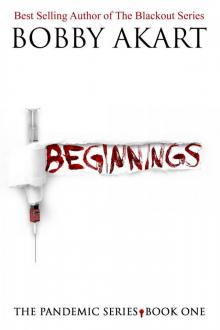 Pandemic: Beginnings: A Post-Apocalyptic Medical Thriller Fiction Series (The Pandemic Series Book 1)
Pandemic: Beginnings: A Post-Apocalyptic Medical Thriller Fiction Series (The Pandemic Series Book 1)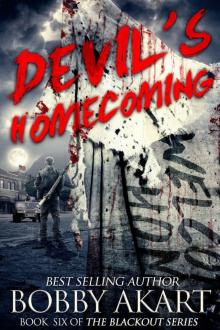 Devil's Homecoming: A Post Apocalyptic EMP Survival Fiction Series (The Blackout Series Book 6)
Devil's Homecoming: A Post Apocalyptic EMP Survival Fiction Series (The Blackout Series Book 6)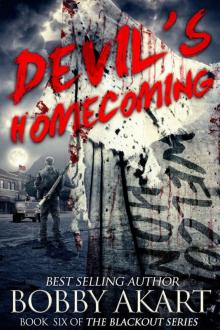 The Blackout Series (Book 6): Devil's Homecoming
The Blackout Series (Book 6): Devil's Homecoming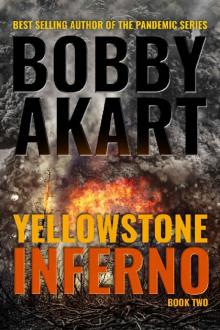 Yellowstone: Inferno: A Post-Apocalyptic Survival Thriller (The Yellowstone Series Book 2)
Yellowstone: Inferno: A Post-Apocalyptic Survival Thriller (The Yellowstone Series Book 2)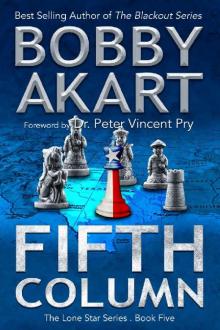 Fifth Column: Post Apocalyptic EMP Survival Fiction (The Lone Star Series Book 5)
Fifth Column: Post Apocalyptic EMP Survival Fiction (The Lone Star Series Book 5)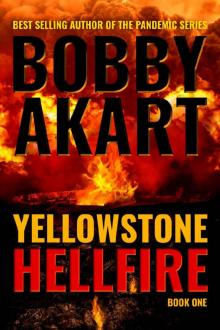 Yellowstone: Hellfire: A Post-Apocalyptic Survival Thriller (The Yellowstone Series Book 1)
Yellowstone: Hellfire: A Post-Apocalyptic Survival Thriller (The Yellowstone Series Book 1) The Blackout Series (Book 2): Zero Hour
The Blackout Series (Book 2): Zero Hour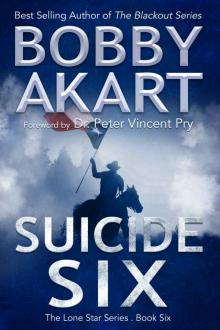 Suicide Six: Post Apocalyptic EMP Survival Fiction (The Lone Star Series Book 6)
Suicide Six: Post Apocalyptic EMP Survival Fiction (The Lone Star Series Book 6)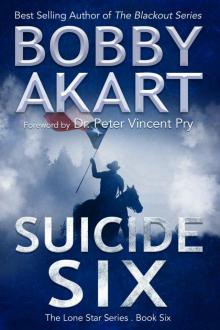 Suicide Six_Post Apocalyptic EMP Survival Fiction
Suicide Six_Post Apocalyptic EMP Survival Fiction Zero Hour: A Post-Apocalyptic EMP Survival Fiction Series (The Blackout Series Book 2)
Zero Hour: A Post-Apocalyptic EMP Survival Fiction Series (The Blackout Series Book 2)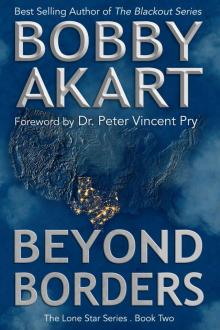 Beyond Borders_Post Apocalyptic EMP Survival Fiction
Beyond Borders_Post Apocalyptic EMP Survival Fiction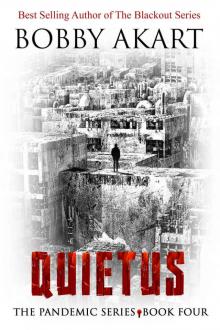 Pandemic: Quietus: A Post-Apocalyptic Dystopian Fiction Series (The Pandemic Series Book 4)
Pandemic: Quietus: A Post-Apocalyptic Dystopian Fiction Series (The Pandemic Series Book 4)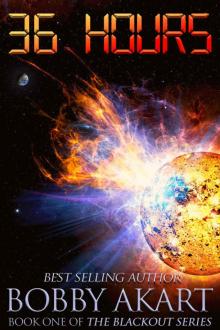 36 Hours: A Post-Apocalyptic EMP Survival Fiction Series
36 Hours: A Post-Apocalyptic EMP Survival Fiction Series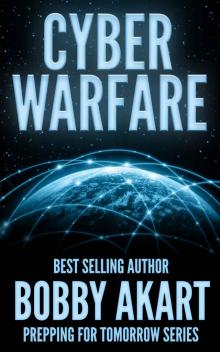 Cyber Warfare
Cyber Warfare